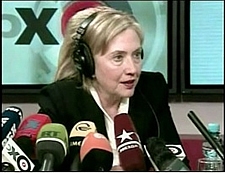 |
|
No preemptive nuclear options, according to Secretary of State Hillary Clinton. |
By Hans M. Kristensen
During an interview with Ekho Moskvy Radio last week, Secretary of State Hillary Rodham Clinton was asked if “the American [nuclear] doctrine incorporate[s] preemptive nuclear strikes against an aggressor?”
The Secretary’s answer was: “No, no.”
Ahem….
Secretary Clinton’s denial that U.S. nuclear doctrine incorporates preemptive strike options is at odds with numerous statements made by U.S. government officials over the past eight years, who have sought to give precisely the opposite impression; that the nuclear doctrine does indeed also contains preemptive options. An draft revision of U.S. nuclear doctrine in 2005 revealed such options.
So unless the U.S. has changed its nuclear doctrine since the Bush administration, then the Secretary’s denial is, well, at odds with the doctrine.
The confusion could of course be academic; that Secretary Clinton is under the impression that the doctrine includes preventive, no preemptive, strike options. Or perhaps she simply doesn’t know, yet believes that preemptive nuclear strike options should not be part of U.S. nuclear doctrine. It is of course important that the U.S. Secretary of State knows what U.S. nuclear policy is, since she is in charge of negotiations with Russia about the START Follow-On treaty and laying the groundwork for a subsequent and more substantial treaty and nuclear relationship.
The context of her denial was an Izvestia interview with Nikolai Patrushev, Secretary of Russia’s Security Council, about Russia’s ongoing review of its nuclear doctrine. Mr. Patrushev reportedly said: “In situations critical to national security, a nuclear strike, including a preventative one, against an aggressor is not ruled out.”
Russia’s current doctrine already allows preemptive strikes, something the Kremlin says it needs because of Russian inferior conventional forces. Whether the new revision will change or reaffirm preemptive options remains to be seen.
Background: Counterproliferation and US Nuclear Strategy (2009); Global Strike Chronology (2006); Doctrine for Joint Nuclear Operations (2005)
This publication was made possible by a grant from Carnegie Corporation of New York and Ploughshares Fund. The statements made and views expressed are solely the responsibility of the author.
The FY2026 National Defense Authorization Act (NDAA) paints a picture of a Congress that is working to both protect and accelerate nuclear modernization programs while simultaneously lacking trust in the Pentagon and the Department of Energy to execute them.
While advanced Chinese language proficiency and cultural familiarity remain irreplaceable skills, they are neither necessary nor sufficient for successful open-source analysis on China’s nuclear forces.
Satellite imagery has long served as a tool for observing on-the-ground activity worldwide, and offers especially valuable insights into the operation, development, and physical features related to nuclear technology.
This report outlines a framework relying on “Cooperative Technical Means” for effective arms control verification based on remote sensing, avoiding on-site inspections but maintaining a level of transparency that allows for immediate detection of changes in nuclear posture or a significant build-up above agreed limits.